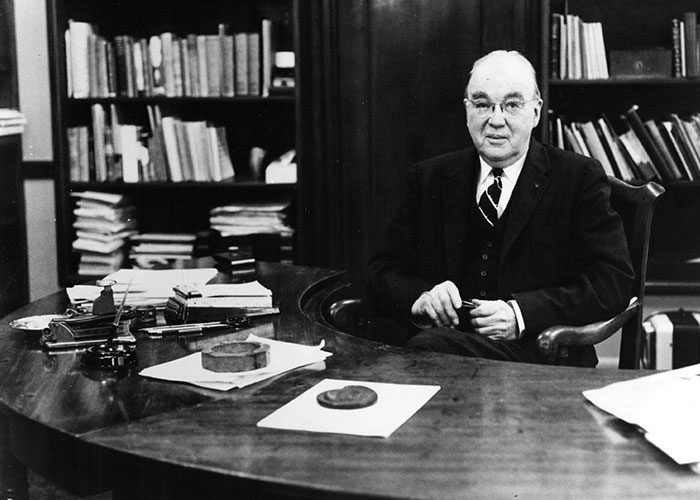A Brief History of the Fellowship Program

Physics Today Collection
Before the inauguration of the Guggenheim Foundation in 1925, Senator Simon Guggenheim wrote, “We all realize that some of the finest minds, some of the most constructive thinkers in the world, have been seriously hampered in turning their natural gifts to the best advantage by the lack of adequate financial backing. I want to do my part to meet this need.” Senator Guggenheim and his wife, Olga, established the foundation in memory of their son, a promising young scholar, who died at the age of 17 in 1922. From its inception, the foundation has sought, as the senator wrote in his first Letter of Gift, to “add to the education, literary, artistic, and scientific power of this country, and also to provide for the cause of better international understanding.”
The United States and Canada Program
The Fellowship competition was at first open only to citizens of either the United States and its territories. In keeping with the Guggenheims’ intentions, as expressed in their First Letter of Gift, the awards were originally titled the “John Simon Guggenheim Memorial Foundation Fellowships for Advanced Study Abroad.” Beginning with the inaugural class of fifteen Fellows in 1926, all Fellows were required to spend their terms outside of the United States. But the foundation was eager to place as few restrictions as possible on the Fellows and so rescinded that requirement with the competition of 1941.
Canadians became eligible for the Guggenheim Fellowships in 1940, and the name of the competition changed to “United States and Canada.”
Residents of the Philippines were eligible from the establishment of the Foundation (for the Philippines were a U.S. territory at that time) until 1988, when the Philippine program was discontinued; applications from the Philippines were considered by the Committee of Selection for the United States and Canada through 1949, when that responsibility shifted to the Latin American Committee.

Origins of the Latin American Program
In 1929, the Trustees of the Foundation sought to more fully realize the goal of “better international understanding” by expanding eligibility for Fellowships to citizens of other countries in the Western Hemisphere. In Senator Guggenheim’s Second Letter of Gift, dated June 7th, 1929, he explained that he and his wife intentionally did not limit the Foundation to appointing Fellows from the United States:
“We had in mind then what we desire to make effective now by this new endowment, namely, to assist in increasing the interaction among the American republics, each upon the other, in the arts and sciences, in education, and in the learned professions.
“My brothers and I have long been engaged in commerce with many of the republics to the south of the United States, and we know that there are no longer any important factors of economic isolation separating us. But a similar commerce of the mind, of spiritual values, is yet to be accomplished. It is Mrs. Guggenheim’s and my hope that this new fund may assist in supplying that great need.”
“We are proceeding in the conviction that we have much to learn in those countries that are our elder sisters in the civilization of America and much to give their scholars and creative workers. That is fundamental to our thinking on this subject. Nor must we fall into the easy error of grouping them all together in our thinking under the general term, ‘Latin American republics’; for they are as individual as our own country is individual, and each will make her distinctive contribution to the commerce of the mind we contemplate.”
Country-specific Committees of Selection were established, first in Mexico (1930), then in Argentina, Chile, and Cuba (1931), and Puerto Rico (1932). With the exception of the Cuban competition, which has always been administered from New York City, these foreign competitions were managed entirely in their individual countries. However, the prohibitive expense of this decentralized administration led the Foundation to center all competitions in New York City, beginning in 1934. With the competition of 1940, Brazil, Peru, and Uruguay were added to the Latin American roster. By the competition of 1951, citizens and permanent residents of any of the Latin American republics were eligible for Fellowships.
With the addition of the British West Indies to the competition in 1952, the name was changed from “Latin American Fellowships” to “Inter-American Fellowships.” As the competition grew, the name changed again to “Western Hemisphere and the Philippines.” Finally, when the Philippines were eliminated from the program in 1988, the competition took on its name, “Latin America and the Caribbean.”
To date, over 1,800 Fellowships have been awarded in the Latin America and Caribbean competition.